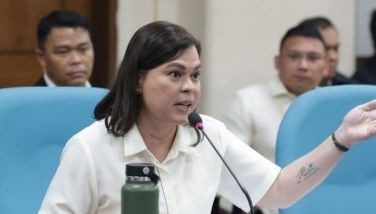'Is Metro Manila safe to live in?'

The best tweet on our horrific experience this week came from Valenzuela mayor Sherwin Gatchalian. “I call on the 17 mayors of Metro Manila to have an in-depth discussion on the vulnerability of the metro. Is Metro Manila safe to live in?”
The mayor then followed that up with this tweet: “After 50 years, Ondoy. After four years, habagat. Our constituents cannot live in fear every rainy season. Is MM really safe to live in?” Hmm… at last there is a Metro Manila mayor who has connected the dots.
The problems of this metropolis of over 10 million people cannot be solved by tribal leaders masquerading as mayors of the 16 cities and one town in Metro Manila. The floodwaters in Quezon City flows to Valenzuela and then to Malabon and Navotas and create havoc along the way… the same thing with the dengue carrying mosquitoes that do not recognize political boundaries between cities.
I had always thought Metro Manila needs a metrowide government of some kind to handle its interrelated problems. It seems an obvious conclusion to everyone but the mayors: a business like approach through some kind of metropolitan government.
Perhaps we had a chance to do that when Imelda declared herself Metro Manila governor during the martial law era. But unfortunately, she was more into the aesthetics of things rather than deal with the more difficult, but more crucial problems like flood control, traffic management, urban planning, health services delivery, etc. Her deputy Mel Mathay was more interested in garbage collection but not what to do with all of that basura other than create Smokey Mountain and Payatas.
Now the sh-t is really hitting not just the ceiling but everyone in the 16 cities and one town comprising Metro Manila. I once attended a meeting where Oscar Lopez wondered aloud if it was possible to have the 17 mayors working together and think of Metro Manila’s problems as one that requires them to work together. I think Raffy Alunan, a former DILG secretary was in that meeting and we sadly told Mr. Lopez that he is correct but that’s an impossible dream.
The problem with Metro Manila mayors is that they are all petty politicians who are more interested in protecting their local fiefdoms than really solving problems of urban management. The MMDA is largely toothless and relegated to handling traffic management but even at that, limited according to the whims of particular mayors.
Thus Makati had long ago declared its independence from MMDA. I remember the fight between a strong willed MMDA chief Bayani Fernando and an even stronger willed mayor Jojo Binay over what to do to manage traffic at the corner of C-5 and Kalayaan. How can they be expected to work together on other more contentious things like sanitation, building permits and what to do with informal settlers?
The result is what we see and experience now… death, disease and disarray. Ondoy and this week’s habagat merely dramatized the seriousness of our problems which can only get more unbearable with each passing year. The thing is… climate change is undeniably upon us and our country has been declared as among the most disaster prone due to climactic changes.
Early this year, Margareta Wahlström, special representative of the UN secretary general for disaster risk reduction came to Manila to deliver that message of concern. The Philippines topped the list of Asian countries hit by disasters in 2011, according to a recent report of the Center for Research on the Epidemiology of Disasters (CRED). The number of disasters that hit the country in 2011 totaled 33, claiming 1,430 lives. The figures are way higher than China’s 21, India’s 11, Indonesia’s 11, and Japan’s seven.
Our country also topped the list of the highest number of people affected by calamities like floods, storms and earthquakes in 2011. There were 1,147,270 Filipinos adversely affected, according to the World Health Organization collaborating center, surpassing Japan’s 368,820.
Rappler, the web-based news source, reports that disasters cost the country P15 billion every year. Damages caused by tropical storm Sendong alone are estimated to amount to P1.3 billion (roughly $29.6 million). Wahlström noted that economic growth in areas vulnerable to disasters around the world could not keep pace with institutional capacity to manage resources and disaster risk reduction.
According to Rappler, the UN official observed during her visit to Sendong-devastated Iligan and Cagayan de Oro, that many “municipalities lack practical experience on how to plan (for disaster risk reduction), how to prepare and how to keep it going.” This, she said, is the biggest gap on the ground. For all practical purposes, the inadequacy of Iligan and Cagayan de Oro in responding to floods is also true in Metro Manila, the seat of our National Government.
Wahlström emphasized the need for the National Government to guide local governments “because there is a collision of interests -- economic development must be weighed against people’s safety.” She stressed that because the country is disaster-prone, there is a need to address the gap even as it competes with other priorities.
The UN official is just scratching the surface. The clash of priorities is even more basic – local officials will prioritize projects that enhance their political staying power. For instance, it is to the interest of Metro Manila that the Sierra Madre hills where the floodwaters come from are reforested. But don’t expect them to work together to see that happens.
Wahlström is right. “Let’s make sure that we are using the opportunities now to mitigate future impact. We have the resources and we have the partnerships, and let’s move along this agenda.” Otherwise we just move on from Ondoy to Sendong to habagat to the next big calamity and show the world we have learned nothing from these tragedies.
Commenting on a New York Times report of this week’s floods, a reader, Peter Geerts who listed his address as Tagaytay had this to say:
“Manila population could be 16m population at any time, some sources suggest 20m. Whatever the numbers: it’s over its neck since some time and growing. Every minute that passes is a chance....
“Some sweeping needs to be done: relocation of some specific urban activities (administration, specific businesses, education) offers a sudden opportunity to master plan the new location well and offer better living and working conditions. Because it’s not only just now with this flooding really that the city is hard to live and work in. It just requires a long term vision.”
Tomas Gomez III, a former press secretary of Tita Cory wrote this view:
“MetroManila is abused space. It is engaged in self-strangulation by not consciously decongesting and redistributing its population. Slums and squatter colonies predominate much of the terrain, occupying what used to be open canals/streams, river tributaries and even riverbanks themselves.
“Clogging of natural drainage arteries is the tolerated norm. It is beyond its carrying capacity and for a long time now has been bursting at the seams and there is no national policy/initiative to decongest, to demagnetize and to deimperialize.
“There is mass transit that goes around in circles within the metropolitan core instead of ferrying masses of people over long distances to and from the city. There is no such thing as a “freeway” or a “highway” cutting through the metro area through which you can travel at a speed of better than 10 mph.”
“All of its 636 sq.km. has a daytime population that is approaching 30,000 per sq. km. Manila itself is now planet earth’s most densely populated municipality. Yet, as the crow flies, just beyond 40 miles to the northeast, east and southeast of Manila are verdant open spaces waiting to be opened up to efficient infrastructure and a better quality of life. What a country!”
Yes sir… we could certainly do better if we had a Metro Manila government with the political clout to do what is right beyond the tribal interests of 17 mayors. I am glad one of the mayors, a young man who was elected with a lot of promise for modern governance, is asking the right question.
Is Metro Manila safe to live in? I hope the other 16 mayors will rise up to the challenge posed by mayor Gatchalian to meet and find out how they can do things better. We cannot go on living like this in fear of the rains year after year. Personal and local interests must give way to a metro wide outlook.
We need to make sure Metro Manila is safe to live in. Our lives and that of our families depend on our mayors being enlightened enough to do the right things.
Politicians
To succeed in politics, it is often necessary to rise above your principles.
Boo Chanco’s e-mail address is [email protected] Follow him on Twitter @boochanco
- Latest
- Trending
































